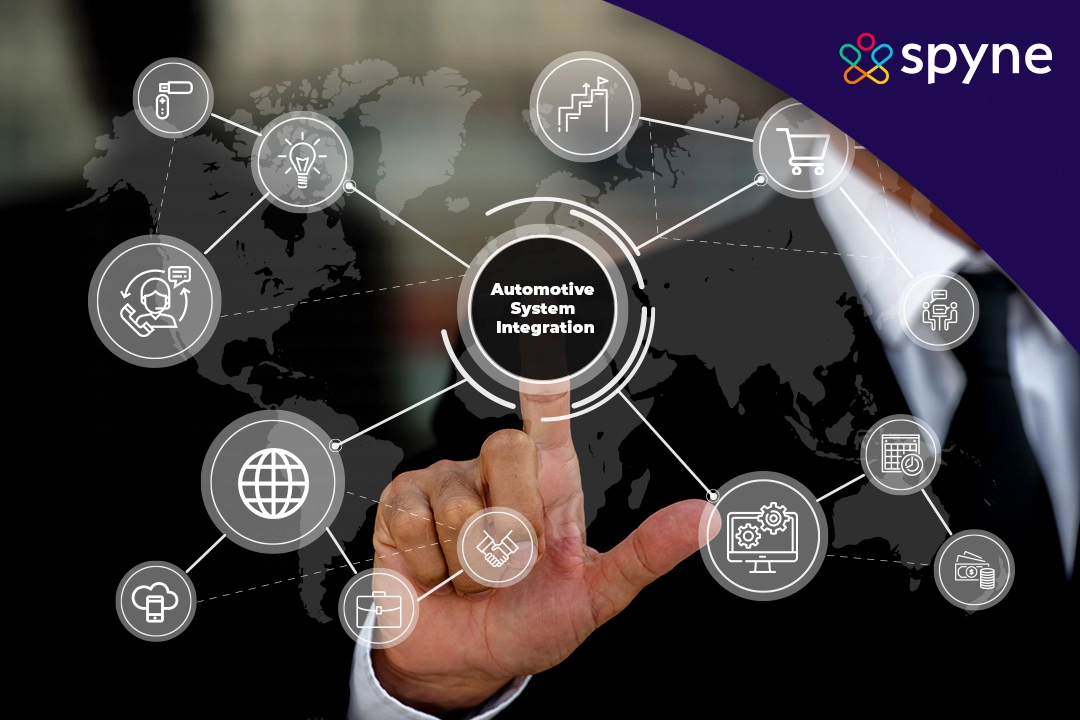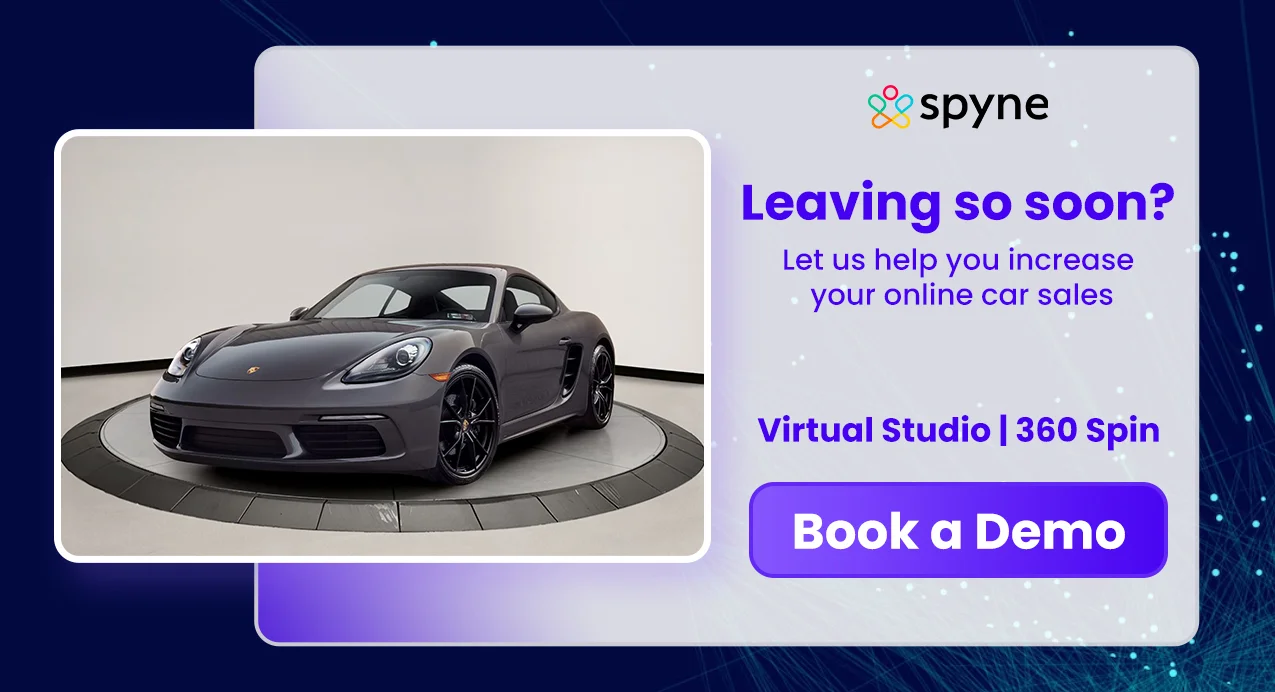Every car dealership wants a system that will help them run their business smoothly like a high-performance engine. Thanks to automotive system integration that does its job and makes dealerships’ wishes turn into reality. This integration combines systems and technologies into one integrated system which ensures that automotive dealerships operate at peak efficiency.
This blog will provide you with roles, types, and challenges in automotive system integration. Stick till the end to learn about the tools for integration & upcoming future trends!
What is Automotive System Integration?
Automotive system integration combines components and sub systems into one, ensuring the systems work together and function the way it is programmed to. In automotive dealerships, comprehensive vehicle system integration can help them with their services. It also helps by enhancing their operations and customer experience. The system can handle multiple operations like sales, inventory management, marketing campaigns, and tracking leads simultaneously. This helps dealerships provide personalized customer experiences, increase sales, and drive the business to success.
The Shift Toward Software-defined Vehicles
The automotive industry is moving toward software-defined vehicles (SDVs) due to increasing demand for connectivity, autonomy, electrification, and shared mobility. Cars are evolving into smart, connected devices with complex automotive software software controlling everything from basic functions like engine and brakes to advanced features such as autonomous driving. This transformation has significantly increased the amount and complexity of software in vehicles, making them more reliant on sensors, actuators, and computing power. Software is now a key element in modern vehicles’ functionality and innovation.
Role of Automotive System Integration
The role of automotive dealer system integration is considered crucial nowadays due to the increase in competition in the automotive industry. The automotive software controls the operations of a car dealership, and as an auto integrator, its job is to make the dealership’s services better by implementing strategies. The automotive dealer management system integration strategy is designed in such a way that enhances the efficiency and effectiveness of dealerships, promoting the growth of the customer base, increasing website traffic, communicating with potential buyers, and tracking the leads. Here are some more ways through which it plays its role:
1) Better Customer Service
Integrated systems make customer service better. It ensures quick and accurate repairs. These systems help dealerships find and fix problems faster, so customers don’t have to wait long for their cars. Dealerships can see detailed information about each customer’s car history and preferences, which helps them offer personalized offers. Customers get real-time updates on their car’s status making the process transparent and building trust.
2) Boosting Sales and Managing Leads
In terms of sales and leads, vehicle system integration is a big help. It allows dealerships to find potential customers and send them personalized offers, making automotive digital marketing more effective. Sales teams can easily show off advanced car features, making it simpler for customers to understand and appreciate the benefits. Integrated systems keep track of customer inquiries and follow-ups, ensuring no potential sale is missed and improving lead management.
3) Smart Inventory Management
Smart automotive inventory management is another area where car integration shines. Dealerships can keep better control of their stock, making sure they have the right cars and parts to meet customer needs without overstocking. Automated reordering ensures that when stock is low, new parts or vehicles are ordered automatically, preventing shortages. This efficient management reduces waste by minimizing unsold stock and the costs of maintaining unnecessary inventory.
4) Keeping Everything Organized
Keeping everything organized is important, and integrated systems excel at this. They help maintain detailed records of customer interactions, preferences, and purchase history, which leads to better service and more personalized experiences. Dealerships can also track the status of cars being serviced or sold, providing timely updates to customers. Managers can monitor KPI for automotive dealership like sales figures, service times, and customer satisfaction, helping them make better decisions and improve overall performance.
The Rise of the Software Systems Integrator
Software systems integrators are vital in this shift, connecting traditional automotive engineering with a software-driven future. These experts possess both hardware and software knowledge and navigate the complexities of integrating different systems within the vehicle. Their role ensures that vehicle components work together seamlessly, making them critical for balancing the mechanical and digital elements. As vehicles become more sophisticated, the software systems integrator becomes increasingly important in coordinating various software components for smooth functionality.
Skills and Responsibilities
- Technical Expertise: Strong knowledge of both software development and automotive hardware is essential.
- Systems Thinking: Ability to understand how various vehicle components interact and affect each other.
- Problem-solving: Capable of addressing complex auto integration challenges to ensure all systems work smoothly together.
- Communication: Bridging the gap between software developers, hardware engineers, and non-technical stakeholders through clear and effective communication.
The Role of Integrator in Automotive R&D
- System Architecture Design: Creating scalable and flexible software structures for vehicles.
- Integration and Testing: Merging software from various sources, ensuring compatibility with hardware.
- Quality Assurance: Implementing strict testing protocols to maintain high safety and performance standards.
- Continuous Improvement: Keeping up with technological advancements and optimizing software systems regularly.
Why is Automotive System Integration Important?
In the automotive industry, the job of automotive integrator is important in the implementation of systems and technologies. They are responsible for ensuring the smooth and proper functioning of the different systems in the dealership. The rapid growth in this market has resulted in demand for advanced features and technologies in vehicles, as well as software and system integrators.
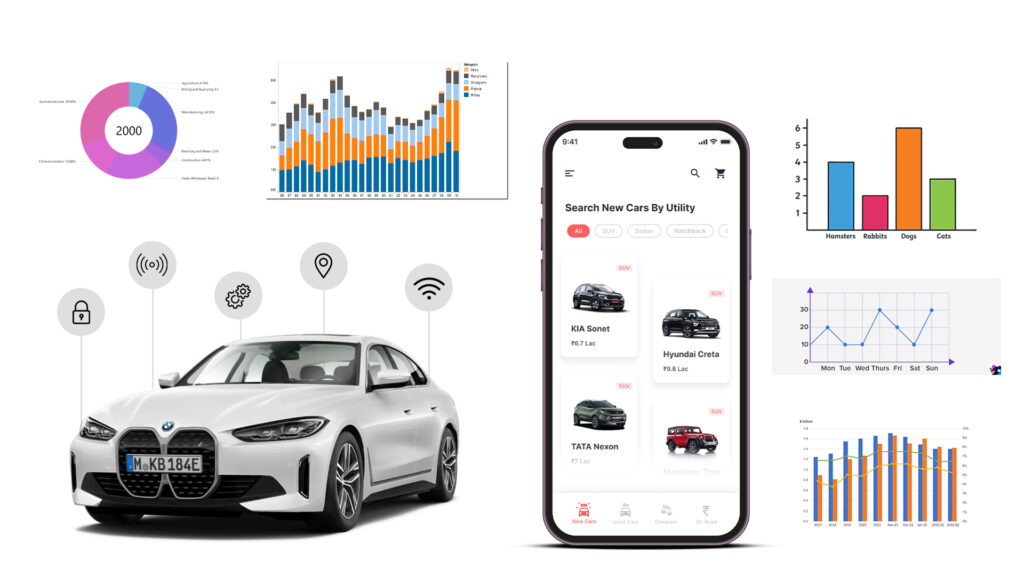
The systems are meant to meet these demands and focus on enhancing the dealership’s performance and user experience.
Automotive System Integration Testing
In car dealerships, besides vehicle inspection, testing car system integration is really important to make sure everything runs smoothly and customers are happy. Testing helps dealerships work efficiently and gives a good experience to both staff and customers. Here are some tests done to ensure the smooth functioning of systems:
1) Functionality Testing
This testing ensures that every part of the software works correctly as it’s supposed to. For example, it checks if the software can process sales transactions accurately, manage customer records without errors, and generate financial reports as needed.
2) Integration Testing
Integration testing makes sure that different parts of the dealership software work well together. It tests how data moves between different sections of the software and ensures that everything connects smoothly. This is important so that the entire software system operates as a unified whole. Integration testing focuses on interface compatibility that ensures that data is exchanged without any errors.
3) User Interface Testing
UI testing focuses on how easy the software is to use for dealership staff. It checks things like the layout, design, and functionality of the interface to ensure it is intuitive and user-friendly. Good UI testing ensures that users can navigate the software easily, perform tasks efficiently, and find information without any confusion.
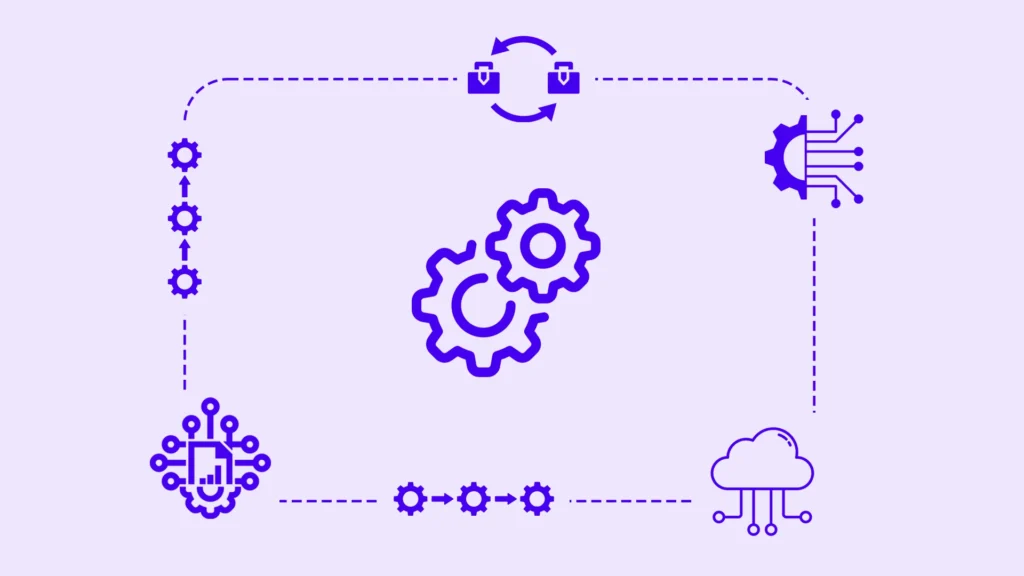
4) Performance Testing
Performance testing evaluates how well the software performs under different conditions. It includes stress testing to see how stable and reliable the software is under heavy workloads or during busy times. It also checks if the software can handle a large number of transactions without slowing down or crashing.
5) Security Testing
Security testing is vital for protecting sensitive information in the dealership software. It looks for any weaknesses that could allow unauthorized access, data breaches, or harmful activities. This testing ensures that data is encrypted properly, authentication methods are strong, and information is transmitted securely.
6) Usability Testing
Usability testing gathers feedback from real users to understand how they experience the software. It focuses on aspects like how easy it is to learn the software, how efficiently tasks can be completed, and overall user satisfaction. This helps identify areas where the software can be improved to make it more user-friendly and increase productivity for dealership staff.
Types of Automotive System Integration
The automotive system integration strategy aims to enhance operational efficiency, improve data accuracy and accessibility, and support decision-making processes within the automotive industry. Here are several types of system integration automotive integrators commonly use:
1) Vertical Integration
Integrating subsystems or components within the same industry or supply chain to streamline operations and improve efficiency. For example, integrating manufacturing processes with car inventory management systems in automotive production.
2) Horizontal Integration
Integrating similar or related subsystems or components across different industries or departments within an organization. For instance, integrating customer relationship management (CRM) systems with sales and marketing automation tools in automotive dealerships.
3) Enterprise Application Integration (EAI)
Integrating various enterprise applications, databases, and systems to enable seamless communication and data exchange across an entire organization. This could involve integrating ERP (Enterprise Resource Planning) systems with production planning and supply chain management systems in automotive manufacturing.
4) Data Integration
Automotive data integration from disparate sources or formats into a unified format or platform. For example, integrating vehicle telematics data with customer service records and inventory data in automotive service centers.
5) Cloud Integration
Integrating cloud-based services, applications, and platforms with existing on-premises systems or other cloud services. This allows for scalability, flexibility, and accessibility of data and applications across different locations or devices within the automotive industry.
6) B2B Integration (Business-to-Business)
Integrating systems and processes between different businesses or trading partners to facilitate transactions, supply chain management, and collaboration. This could involve integrating procurement systems with suppliers’ inventory systems in the automotive supply chain.
7) IoT (Internet of Things) Integration
Integrating IoT devices, sensors, and data streams into existing systems to enable real-time monitoring, analytics, and automation. For instance, integrating vehicle IoT sensors with maintenance scheduling systems in automotive fleets.
System Integrators in Automotive Market Analysis and Latest Trends
In the automotive industry, system integrators play an important role in implementing and optimizing various systems and software solutions used by dealerships. Here is an analysis of the systems and software trends currently shaping the automotive market:
1) Integrated Digital Retailing
Customers can now browse, visit virtual showrooms, and complete car purchases online. These digital platforms connect with dealership systems to make the sales process easier and more convenient.
2) Customer Relationship Management (CRM)
Automotive CRM systems use advanced features to better manage customer interactions, improve lead management, and boost customer loyalty through personalized communication and insights.
3) Inventory and Service Management
Advanced inventory systems track vehicle stock in real time and work with sales and marketing. Service management tools help schedule appointments, manage operations, and enhance customer service using technology for predictive maintenance and automated notifications.
4) Data Analytics and Cybersecurity
Dealerships use data analytics to gather insights from sales and service data, helping make better decisions and improve efficiency. Strong cybersecurity measures are essential to protect systems and customer information from cyber threats.
5) Regional Growth in Automotive System Integration
Automotive system integrators are seeing rapid growth globally. This is due to the rising demand for vehicle connectivity and automation which is being driven by advanced technologies. APAC leads the market with a 45% share, followed by North America (30%), Europe (20%), and the USA (5%).
The Challenge of Software Insourcing
OEMs are increasingly insourcing software development from Tier 1 suppliers to speed up ‘code to car’ in agile cycles. Insourcing software development for automotive systems gives companies more control and customization, but it also has challenges in integrating various software systems into a unified vehicle architecture. Some are listed below:
1) Resource and Cost Challenges
Insourcing requires a lot of internal resources like skilled workers, time, and money. Companies need a dedicated team for software development and maintenance, which can strain current resources and shift focus away from main business activities. While it may seem cheaper initially, hidden costs from specialized tools, training, and unexpected technical issues can increase expenses.
2) Technical and Integration Difficulties
Integrating complex automotive systems is tough, especially if the in-house team lacks experience with specific tools and platforms. Keeping up with fast-changing technology and ensuring staff training is challenging. Integrating multiple systems like automotive CRM, ERP, inventory management, and IoT devices requires ensuring smooth communication and data flow, which can be complex and prone to technical issues.
3) Scalability and Innovation Limitations
Growing and maintaining software in-house can limit scalability. As the business expands or new automotive integrations needs arise, the in-house team might struggle to scale solutions effectively, leading to delays and increased costs. Insourcing can also limit access to outside innovation and best practices, as external vendors often bring diverse experiences and innovative solutions from working with many clients.
4) Project Management and Maintenance
Managing large software projects internally demands strong project management skills. Coordinating between departments, managing timelines, ensuring quality, and handling unexpected issues can be overwhelming. Poor project management can result in delays, budget overruns, and poor vehicle infrastructure integration outcomes. Ongoing maintenance and support require continuous effort, with a dedicated team needed to fix bugs, update software, and address technical issues.
5) Security, Compliance, and Time-to-Market
Developing software in-house requires strong security measures to protect data and comply with industry regulations like GDPR. Implementing good automotive cybersecurity practices and meeting regulatory standards is resource-intensive. In-house development and integration can take a long time, making it hard for the company to quickly respond to market demands and new technologies, impacting competitiveness and customer satisfaction.
Challenges in Automotive System Integration
Automotive source system integration comes with numerous challenges. These challenges range from managing resource allocation and requiring specialized technical expertise to handling the complexities of automotive system integration and ensuring robust security. Some other challenges are listed below:
1) Resource Allocation: Managing internal resources like skilled staff, time, and budget can strain operations and divert focus from core business activities.
2) Technical Expertise: Integrating complex automotive systems requires specialized knowledge; lacking experience with specific tools can lead to errors and inefficiencies.
3) Scalability Issues: Difficulty in scaling in-house systems to meet growing or changing business needs may result in delays and increased costs, hindering business growth.
4) Project Management: Effective management of large automotive integration solutions and projects is crucial; poor coordination and timeline management can lead to delays and budget overruns.
5) Integration Complexity: Integrating various systems involves high complexity; ensuring smooth communication between different systems can be challenging.
6) Maintenance and Support: Ongoing maintenance and support for in-house systems demand dedicated resources; keeping software updated and resolving issues is essential for system reliability.
7) Software Integration Challenges: Updating one module often disrupts the entire system which causes delays. AI tools can help you by visualizing these changes in software integration testing in automotive modules and resolving errors quickly. These tools ensure smoother automotive software integration.
8) Minimizing OTA Update Costs: Systems need frequent OTA updates for security, performance, and new features. So you should aim to reduce update costs and ensure seamless, downtime-free updates. These are essential for improving user experience and unlocking additional revenue opportunities.
Digital Prototyping and Predicting NVH Performance with Component-based Analysis
The automotive industry is moving away from using physical prototypes to test noise, vibration, and harshness (NVH). With the growing variety of vehicle models, physically validating component integration in every configuration has become impractical. Instead, the focus is shifting toward digital development to reduce both time and costs.
Transition to Virtual Prototyping in the Industry
Component-based Transfer Path Analysis (C-TPA) is essential for moving from physical to virtual prototypes. It characterizes each vehicle component individually through testing or CAE methods. By mathematically combining component data via Frequency-based Sub structuring, engineers can efficiently simulate design changes, saving time and costs across various vehicle configurations.
Utilizing Component Data for NVH Simulation
C-TPA differentiates between source components that create operational excitations and receiver components that transmit these excitations to NVH targets. Source components use ‘invariant’ loads and Frequency Response Functions (FRFs) for modeling, while receiver components rely on impedance FRFs. This standardized data allows for easy reuse in future virtual assemblies, streamlining engineering efforts.
Transforming OEM-Supplier Dynamics with Blocked Forces
The automotive sector aims to clarify responsibilities between OEMs and suppliers. C-TPA facilitates this by generating component data independently at various development stages. Utilizing invariant metrics like blocked forces as design targets ensures that desired vehicle-level NVH performance is consistently achievable, enhancing collaboration between OEMs and suppliers.
Confidently Predicting NVH with Validated Technology
As C-TPA becomes more recognized in the automotive field, new users can leverage extensive validation work already conducted on numerous component types. This established credibility provides confidence in predicting NVH performance, encouraging adoption and integration of this technology into vehicle development processes.
Future Trends in Automotive System Integration
The future of automotive systems is all about connectivity and intelligence. Cars are transforming from simple machines into data-driven companions, and automotive source system integration will be key to unlocking their full potential. These are some of the future trends you will get to see in the automotive industry:
1) Connected Vehicles and IoT Integration
Cars will increasingly connect with IoT devices, like sensors and smart systems, to enable real-time diagnostics and predictive maintenance. This means vehicles can detect issues early and schedule repairs before problems worsen, making them more reliable and efficient. It is predicted that in 2024, 72% of passenger vehicles in the US would qualify as connected cars.
2) AI and Machine Learning Impact
AI and machine learning will play a big role in improving cars. These technologies will analyze large amounts of data to predict when vehicles need maintenance, improve how they perform, and personalize driving experiences. For example, AI can adjust settings based on individual driving habits to make each ride smoother and safer.
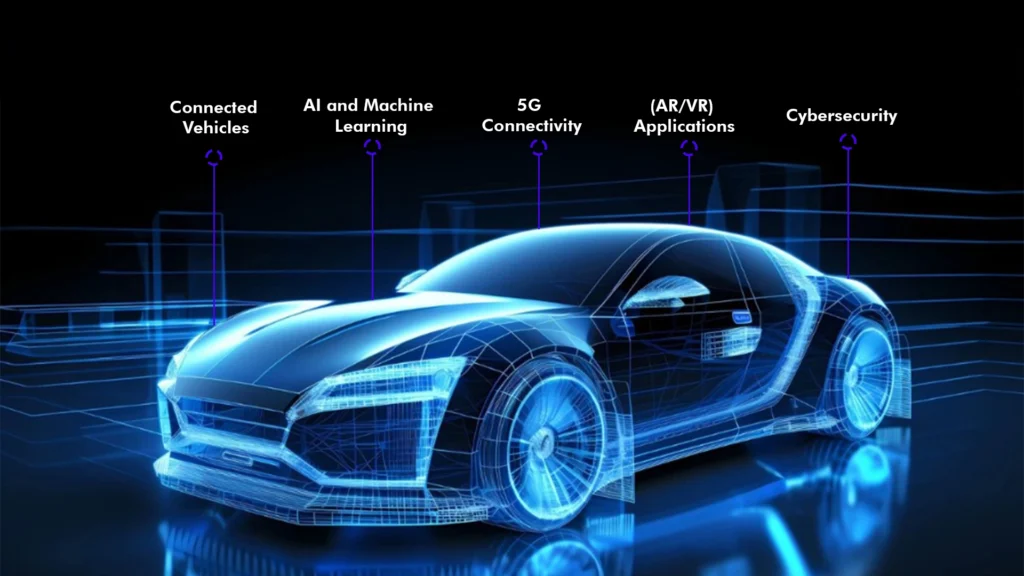
3) 5G Connectivity Advancements
The adoption of 5G networks will greatly enhance how cars connect to the world around them. With faster and more dependable communication, vehicles can share information instantly, which is crucial for things like autonomous driving and getting real-time traffic updates.
4) Augmented and Virtual Reality (AR/VR) Applications
AR and VR technologies will transform how people interact with cars. They’ll be used for designing vehicles, creating virtual showrooms where customers can explore different models and even training drivers. This makes the car-buying process more interactive and helps drivers learn about new features more engagingly.
5) Cybersecurity Measures
As cars become more connected, protecting them from cyber threats becomes increasingly important. Manufacturers will use advanced encryption and security protocols to safeguard vehicle data and systems. This ensures that personal information remains safe and that cars operate securely in an interconnected world.
6) Autonomous Driving
Autonomous driving is revolutionizing the auto industry, driven by AI, sensor technology, and high-speed connectivity. This shift toward software-defined vehicles allows for remote updates, enhancing safety, convenience, and innovation through new features and functions like advanced driver assistance and infotainment.
7) Zonal Architecture
As vehicles grow increasingly complex, the industry is transitioning to zonal architecture, where physical zones replace traditional functional domains. Multi-functional zonal controllers handle various tasks, connected through a high-speed network to a central compute unit for advanced sensor processing and real-time decision-making.
8) Software-Defined Vehicles
Software is increasingly crucial in vehicles, enabling new functions and upgrades through software (SW) updates rather than hardware changes. Software-defined vehicles use general-purpose processors for multiple functions, allowing for remote updates, feature customization, and seamless connectivity.
9) Semiconductor Advancements
Modern vehicles rely heavily on semiconductors to power everything from infotainment to battery management. High-performance chips enable advanced software applications and AI which is essential for the future of automotive industry.
10) Vertical Integration and Strategic Alliances
OEMs and suppliers are increasingly shifting toward vertical integration to enhance control over semiconductor and software development. This approach fosters innovation but also introduces complexities. To support this shift, new partnerships and collaborations are crucial, enabling OEMs to integrate essential technologies and mitigate risks, such as chip shortages.
Conclusion
From managing sales and inventory to running marketing campaigns and enhancing customer experiences, system integration plays an important role. In today’s competitive automotive industry, this integration isn’t just beneficial—it’s essential. As technology evolves, so too will automotive system integration companies, promising even more streamlined operations and exciting innovations in the future.
So, whether you’re a dealer or a customer, embracing automotive system integration means smoother rides, better service, and a journey toward automotive excellence. Here’s to powering your dealership toward greater success!

